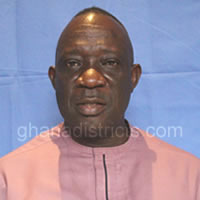PHYSICAL FEATURES
Location and Size
The District is located north of the middle belt of the Volta Region of Ghana and forms part of the six (6) northern districts of the Region. It is bordered to the north by Nkwanta District, to the south by the Jasikan District, to the North West by Krachi East to the south east by Biakoye District. Kadjebi district has a long boarder eastwards with the by the Republic of Togo and has a total land area of 949 km2. The strategic location of the district promotes cross border activities with the republic of Togo.
RELIEF AND DRAINAGE
The district has an average height of about 180 meters above sea level rising to about 600 meters towards the Ghana – Togo Border. The district is blessed with beautiful landscape of hills, mountains and valleys. The land form however is not a hindrance to road construction in the district.
Several rivers, rivulets streams and springs flow all over the district but three (3) major rivers run through the entire district. They are the Asukawkaw, Wawa and Menu rivers that take their sources from the Akwapim–Togo hills and drain into the Volta Lake. River Asukawkaw is the largest of the three and flows for about 25 km westwards out of the district.
These rivers offer possible basis for the introduction of small-scale irrigation activities in the agriculture sector in the district.
VEGETATION
The Kadjebi district especially in the rainy season is generally green with trees covering beautiful landscape of mountains, hills and valleys. 90% of the district is predominantly covered with secondary rain forest. The forests have economic trees such as wawa, mahogany, odum, red wood, raffia palm and bamboo grooves to support the wood processing industry. Animal and bird species such as antelopes, monkeys, glasscutters, weaverbirds and parrots abound in the forest. The forest reserve with its animal and bird species is potential for eco-tourism development in the district.
About 18% of the land area of the district is under forest reserve with dense tropical rainforest. These are the Pepesu and the Kabo Forest reserves. As a result of establishing more wood processing industries in the district and in adjoining once like Jasikan and Hohoe and also the influx of people from all over the country and beyond Togo most especially who depend on products from the forest (timber) as major source of income are speedily being depleted.
GEOLOGY AND SOILS
The district is predominantly underlined by the Buem formations which forms 70% of the total rock. The Togo series occurs to the eastern sides of the district to form the remaining 30% of the sub terranean structure. The district is made of quartzite, phylites, arkose, shale and sandstone. There are also traces of alluvial gold deposits on the banks of river Wawa and clay deposits at Asato, Dodo-Amanfrom and Kadjebi. However, prospecting for alluvial gold in large quantities is being carried out along the banks of Wawa River at Ahamansu. Also the quality of the clay deposits is yet to be assessed by the Geological Department on behalf of the Assembly.
Further feasibility studies on these deposits will have to be carried so as to determine their quality and viability for exploitation. There are large caves located in some hills which could be developed into tourism in the district.
The most predominant type of soil found in the district is the forest ochrosol. This soil includes the alluvial loams which are found along the three major rivers in the district. The soil supports the cultivation of agricultural crops such as cocoa, plantain, cocoyam, cassava, yams, maize and rice.
C L I M A T E
The climate in the district is characterized by average monthly temperature of about 25oC and rainfall is between 1400 mm and 1800mm. Rainfall is generally heavy and starts from March and ends between October and November each year. The peak of rainfall occurs in June. These conditions are conducive for agriculture production. One major climatic problem, facing the district is severe rainstorms, which destroy farm crops, buildings and also cause severe soil erosion in some places especially during the rains. Also, the prolonged drought during the dry season (December–March) is a major source of worry to farmers who are engaged in dry season agriculture production especially vegetables.
NATURAL ENVIRONMENT
The methods of land clearing for agriculture production coupled with the activities of illegal chain-saw operators are gradually reducing the forest into grasslands in some parts of the district.
BUILDING ENVIRONMENT
Settlements cover small areas and are classified as rural. All settlements within the district are characterized by poor layouts and Waste Management. Lack of settlement layouts has facilitated improper land-use in the built up areas in the district. As a result, buildings are badly constructed and there is indiscriminate refuse disposal and defecating. The poor environmental conditions in the built up areas are associated with erosion of access roads, walkways and foundations of buildings especially in Kadjebi.
HUMAN ACTIVITIES ON THE ENVIRONMENT
Activities such as hunting of animals, palm wine tapping and the method used in land clearing for farming cause bush fires which degrade the environment. Bush fire prone areas in the district include Todome, Dika, Ampeyo, Koru, Pampawie, Dapaa, Olobobi, Pepesu, Bekpo, Dodo-Bethel, Kadjebi, Dodo-Amanfrom and Dodo-Tamale. The Ghana National Fire Service established at Kadjebi has a staff of twelve (12) personnel. Twenty-five (25) Fire Volunteers squads in the district have become dormant because they are not equipped and motivated to fight bush fires in the district. The brand new Fire tender provided by government in 2012 is very effective in fighting in within the district and even beyond.
Sand winning and stone quarrying at Papase and Kadjebi have caused degradation to the environment.
LAND MANAGEMENT
The following categories of Land Tenure System operate in the district:
Stool land
These are tracts of land which are vested in the stools. The traditional rulers exercise control over such land
Clan/family land
About 70% of the land in the towns and villages in the district belong to clans. It is often divided among families within the clan. Ownership and control of this category of land is passed on by inheritance.
Purchased land
These are large tracts of lands which were sold out to settlers by the native landlords. At Kadjebi, vast tracts had been sold out to foreigners. Descendants of the original purchasers of these lands continue to inherit them from generation to generation.
Tenancy user rights
This is also known as “Share Cropping” and consists of two types: Abunu and Abusa. In the Abunu system, the farmer cultivates the land and shares the proceeds equally with the landlord. Under the Abusa system, the landlord takes 1/3 of the total produce while the farmer is entitled to 2/3 of the produce. The Abusa arrangement is the most common practice in the district. Once the produce is harvested from the land, the land reverts to its owner. This restrictive land tenure system (Abusa) could be a contributory factor for small farm holdings in the district resulting in the preservation of most of the original land covers and relatively low agriculture production.
Hired land
Under this land tenure system, the user negotiates to pay cash for the use of a piece of land for a specified period. At the end of this period the land reverts to its owner.
Date Created : 11/21/2017 5:16:02 AM





 facebook
facebook X (twitter)
X (twitter) Youtube
Youtube +233 593 831 280
+233 593 831 280 0800 430 430
0800 430 430 GPS: GE-231-4383
GPS: GE-231-4383 info@ghanadistricts.com
info@ghanadistricts.com Box GP1044, Accra, Ghana
Box GP1044, Accra, Ghana